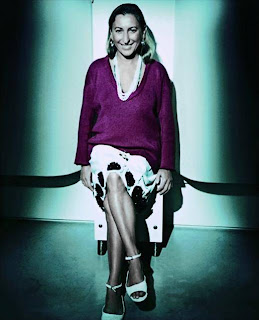Penso que a moda Portuguesa ainda não se libertou totalmente das influências da estética introduzida pelos japoneses e que inundou o mundo da moda nos anos 80. Nesta década os japoneses liderados por Rei Kawakubo, da Comme des Garçons, Issey Miyake e Yohji Yamamoto vieram a Paris para romper com os códigos da moda da época e introduziram uma paleta de cores minimalista, liderada pelo preto, cor que consideravam modesta e arrogante ao mesmo tempo (Yamamoto).
 |
| Yohji Yamamoto SS 2009 |
The classic tailored looks asymmetrical, deconstructed, showing the seams and, sometimes, unfinished, the wild proportions, the extremely elegant minimalism, blazers and jackets with uneven lapels, bars longer on one side and shorter on the other, sleeves do not connect to the rest of the piece, shirts furthest from the body, long and wide skirts - sometimes with a bit of transparency, and dresses with uneven seams and cutouts in different fabrics. You do not have the impression that you're always seeing these formulas repeated in Portuguese fashion?
 |
| Yohji Yamamoto Fall 2009 |
In fact, oversized unfinished silhouettes, and the use of materials not considered in fashion yet as neoprene and felt were concept introduced by Japanese designers, notably Yohji Yamamoto. Ever since Portuguese designers like Ana Salazar felt seduced by this kind of underground conceptualism that changed the traditional codes of fashion which remain today as references to modernity. By now these influences are still felt fully in the mood of Portuguese fashion. Just look at the recent Aleksandar Protic and Ricardo Dourado’s work showed recently in Lisbon fashion week.
De facto, as silhuetas oversized, inacabadas e a utilização de materiais até aqui não considerados na moda como o neoprene e o feltro foram conceitos igualmente introduzidos pelos designers japoneses, nomeadamente, Yohji Yamamoto. Desde sempre que criadores portugueses como Ana Salazar se sentiram seduzidos por essa concepção de moda underground que mudou os códigos tradicionais da moda e que subsistem até hoje como referências de modernidade. Actualmente, estas influências ainda se fazem sentir com bastante intensidade na moda portuguesa. Basta reportarmo-nos aos recentes desfiles, na última edição da ModaLisboa Fall 2011, de Aleksandar Protic e Ricardo Dourado.
 |
| Aleksandar Protic Fall 2011 photo by Paula Lamares |
 |
| Ricardo Dourado Fall 2011 photo by Joao Lamares |
So for those who watched the runway marathon at Lisbon Fashion week where collections were based on similar dark-punk minimalism concepts , it’s always so refreshing to see designers like Alexandra Moura who is always telling her own story that has something to do with his style and universe; Dino Alves who brings to portuguese fashion a sense of humor and irony always surprising; Ricardo Preto with everything always well balanced, more commercial pieces, but still full of fashion information and features the classics; Or Maria Gambina with pieces that seemed to be made of tablecloths, sheets, bedspreads and curtains.
 |
| Maria Gambina Fall 2011 - Photo by Joao Lamares |
 |
| Dino Alves Fall 2011 photo by Joao Lamares |
São criadores que arriscam sair dessa estética dark-punk e do espirito de rebeldia e contra-corrente associado (embora hoje essa conotação já não faça tanto sentido), e constroiem eles próprios conceitos distintos que implicam o uso da cor (Dino Alves), de elementos tradicionais da cultura popular (Maria Gambina) e lusitana (Nuno Gama) e o update contemporâneo do luxo e glamour clássicos (Nuno Baltazar e Miguel Vieira) em contra-corrente com o uniforme minimalista em que por vezes a moda portuguesa se deixa cair.
But I'm really optimistic with regard to Portuguese fashion. The upcoming talents like "Os Burgueses" and White Tent show me that we are in the right way. Portuguese fashion must become more daring, coolest and fashionable and still increase sales and find new potential clients. And we have talent enough to do it. I never see so much public in ModaLisboa like in this last edition. Young people, fashion students, bloggers, people in general who are very well informed about fashion (internet helps!). I think that Portuguese never had so interest in fashion like now. So people became more demanding in what fashion it concerns and Portuguese designers must confront new challenges.
Mas, estou bastante optimista no que se refere à moda Portuguesa. Os novos talentos que entretanto se consolidam como "Os Burgueses" e os White Tent mostram-me que estamos no caminho certo. A moda Portuguesa, contudo, deve continuar a apostar em conceitos próprios e mais atrevidos, mais cool e mais moda, sem contudo deixar de perseguir os objectivos de aumentar as vendas e alargar a clientela a potenciais mercados. E nós temos talento suficiente para isso, a avaliar por esta última edição da ModaLisboa que foi a mais concorrida de sempre. Uma multidão juntou-se nestes 4 dias à porta dos desfiles, desde estudantes de moda, jovens criadores, stylists, bloggers, e pessoas em geral que estão cada vez mais informadas e se mostram mais exigentes ( a internet ajuda!). Eu penso mesmo que os Portugueses nunca andaram tão interessados por moda a avaliar pelo interesse despertado por esta semana da moda. O que só vem afirmar o que disse atrás, os criadores portugueses estão a enfrentar mais desafios e exigências, mas, ao mesmo tempo todo um leque de novas oportunidades se abre para os mais talentosos e persistentes.
Text by Paula Lamares



























No comments:
Post a Comment